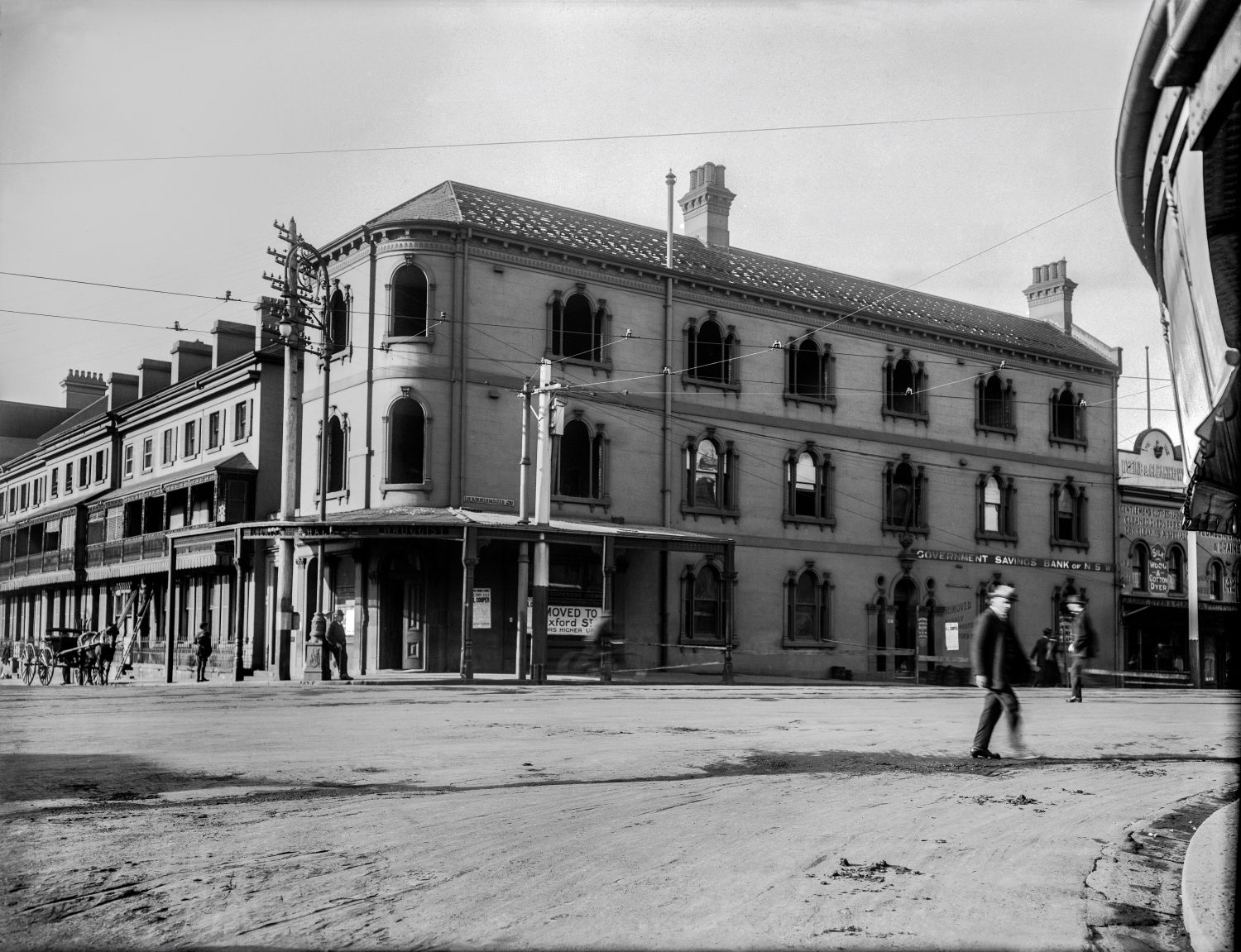
Former Hydropathic Baths, 1917
The former Hydropathic Baths on the corner of Liverpool and College streets, Darlinghurst, prior to demolition, City of Sydney Archives, [A-01000423]
Booth’s Hydropathic Baths were established on the corner of College and Liverpool streets in Darlinghurst in 1880. They were operated by a Mr and Mrs John Booth, who both established a hydropathic bath in Christchurch, New Zealand in 1877 before moving to Sydney.1
Also known as Booth’s Hydropathic or Warm Water Cure Establishment, the three-storey ‘handsome structure’ contained a waiting room and a consulting room with a ground floor occupied by:
…three first-class bath-rooms, fitted up so that as many as 10 different kinds of bath can be given in one room.
Connected with these rooms are two lavatories. Upstairs there are 15 bath-rooms, divided into first and second class; here, also, is the tank which supplies water to the whole house.
Hot water can be forced to any part of the building by a peculiar contrivance invented by Mr Booth.2
According to one advertisement, Booth’s establishment treated ‘All diseases’ and was:
…the Largest and most Complete in all the Australian colonies. It combines all the comforts of a home with the supervision and skill of Mr and Mrs Booth’s 10 years’ practical Hydrotherapeutical experience.
Hydrotherapy, as usually practiced, is associated with cold water and discomfort, but at this establishment heat is the curative agent used, with electric and electric magnet baths.
Ladies and gentlemen wishing to become indoor patients are requested to make arrangements for their reception before leaving home.3
Booth’s Baths featured a large steam boiler, which pumped hot water into ‘all parts’ of the establishment. Each room featured what the newspapers described as an ‘improved Turkish bath’ which consisted of a ‘high cedar box into which the patient walks, the door then being closed’ and the ’lid shut down’, with the patient’s head ‘protruding through a hole’. The patient would then leave the bath and enter a ‘cataract bath, in which there are several taps by which the attendant regulates the quantity, force, and temperature of the water’.
Another treatment for specific organs of the body, ’the pack’ was employed, which involved the patient lying on a bed and being packed in a ‘wet sheet, wrung from tepid water’ and then ‘almost hermetically sealed, like a mummy’. Patients could be assured that not a single patient had been ’lost’ in Booth’s entire career.4
With the exception of infectious diseases, which were ’not on any account allowed on the premises’, Booth claimed to be able to treat the following:
Spinal diseases and injuries of the Spine, Atrophy and consumption of the bowels, neuralgia and nervous complaints, disease of the liver, rheumatism, palpitation of the heart, swollen legs, white swelling, disease of the kidneys, diabetes, piles, nervous fever, sciatica, dropsy, dyspepsia, indigestion, bronchitis etc.5
The Booths operated their baths at the site from about 1880 to 1896, after which he moved to premises on Elizabeth Street and the Liverpool Street site was advertised as ‘under new management’. The proprietor wished to inform the public that the baths comprised ‘Electric, Vapour, Hote Air (Turkish), Sulphur, Mercurial, Russian, and Sitz baths’ and were open daily (Sundays excepted) from 8am until 7pm.6
In the 1900s building was occupied by John C Hallam as a chemist, shops, and then in 1914, the building contained the first ‘flats’ on Liverpool Street, Darlinghurst. It functioned as a boarding house, with 17 rooms. The building was demolished in about 1917.

Former Hydropathic Baths, 1901
The former Booth’s Baths (right) obscured by the military arch temporarily erected on the Hyde Park and College Street corner during ‘Commonwealth Day’, January 1901, Mrs Arthur George Foster, State Library of NSW, [ON 146/210]
Read the next story: Smith and Company’s ‘Places of Amusement’.
Timaru Herald, Volume XXX, Issue 1480, 19 June 1879, 1, https://paperspast.natlib.govt.nz/newspapers/THD18790619.2.2.7, ‘Advertising’, Evening News, 27 November 1880, 8, http://nla.gov.au/nla.news-article108739829, ‘Sydney’, Goulburn Herald, 22 September 1881, 3, http://nla.gov.au/nla.news-article117440353 and ‘Advertising’, Evening News, 12 December 1881, 3 http://nla.gov.au/nla.news-article107226659. ↩︎
The Sydney Daily Telegraph, 20 September 1881, 2, http://nla.gov.au/nla.news-article238307956. ↩︎
‘Advertising’, Australian Town and Country Journal, 11 September 1886, 50, http://nla.gov.au/nla.news-article71067436 and ‘Advertising’, Evening News, 27 September 1886, 8, http://nla.gov.au/nla.news-article107314317. ↩︎
‘The Hydropathic Cure’, The Sydney Daily Telegraph, 10 October 1883, 2, http://nla.gov.au/nla.news-article239271471. ↩︎
‘The Hydropathic Cure’, The Sydney Daily Telegraph, 10 October 1883, 2, http://nla.gov.au/nla.news-article239271471, ‘Advertising’, Macleay Argus, 29 June 1889, 6, http://nla.gov.au/nla.news-article234075931. ↩︎
‘Advertising’, The Methodist, 30 May 1896, 11, http://nla.gov.au/nla.news-article155394920. ↩︎

